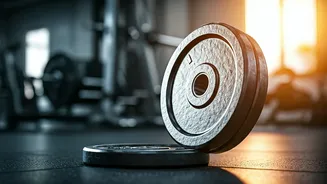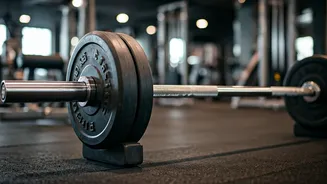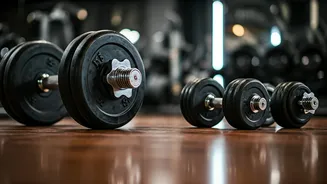The 'Bulk' Myth
The persistent belief that weightlifting automatically leads to a bulky physique in women stems from various misconceptions. One common issue is a lack
of understanding regarding the physiological differences between men and women. Men naturally possess higher levels of testosterone, a hormone crucial for muscle growth, allowing them to gain muscle mass more quickly. Women, on the other hand, have significantly lower testosterone levels. This results in women typically finding it more challenging to achieve significant muscle hypertrophy (growth). Additionally, the perception of 'bulky' often overlooks the nuances of body composition. Weight training, when combined with proper nutrition, can lead to increased lean muscle mass and a reduction in body fat, which can result in a more toned and defined appearance rather than a bulky one. The fear of getting 'too big' also comes from associating weightlifting with the physiques of competitive bodybuilders, who achieve their level of muscle mass through extreme training and specific dietary protocols. It is important to emphasize that achieving that look requires substantial and dedicated effort and is not a typical outcome for women engaging in regular strength training.
Training and Physique
The type of training women choose greatly influences how their bodies respond. Heavy weightlifting with fewer repetitions is more likely to increase muscle size. However, the exact way someone trains is a key determinant. Different training methodologies will cause different types of changes within the body. Focusing on moderate weights and higher repetitions can build strength and endurance without significant muscle size. Incorporating a variety of exercises and varying the rep ranges and weight loads will promote well-rounded fitness and help in shaping the body. This is a crucial factor in understanding how to lift weights without bulking up. Moreover, the frequency of training plays a critical role. Overtraining can lead to muscle fatigue and potentially hinder the desired body composition results. Consistency in following a well-designed workout routine, along with allowing ample time for rest and recovery, is essential for seeing positive changes in physique. The goal of weight training isn't always size, it can be focused on building strength, endurance and overall fitness, all without necessarily increasing bulk.
Nutrition's Impact
Nutrition plays a critical role in shaping a woman's physique while lifting weights. The adage 'you are what you eat' is particularly relevant here. Protein intake is paramount. It is the building block of muscles, and adequate protein is essential for muscle repair and growth after workouts. Consuming enough protein-rich foods, like lean meats, fish, eggs, and plant-based protein sources, supports muscle development without unnecessary bulk. Calorie intake also greatly influences the outcome. If the goal is to increase muscle size, a slight calorie surplus may be necessary. This involves consuming slightly more calories than are burned. However, if the aim is to maintain or decrease body fat while building strength, a balanced diet with a focus on nutrient-dense foods is essential. Focus on complex carbohydrates, healthy fats, and adequate vitamins and minerals. Staying hydrated is also very important. Water is critical for various bodily functions, including muscle recovery and overall energy levels during workouts. Proper nutrition is not just about the type of foods consumed, but also the timing of meals. Consuming protein and carbohydrates after workouts can aid in muscle recovery and replenish glycogen stores, contributing to the desired physique transformation.
Hormones and Women
Hormonal differences between men and women significantly impact how their bodies respond to weightlifting. As mentioned before, women have lower levels of testosterone, a key hormone that is linked to muscle growth. This means women typically find it more challenging to add muscle mass compared to men. However, women's bodies do produce other hormones that can affect their physique. Estrogen, for instance, plays a role in fat distribution. It can affect where fat is stored in the body. Furthermore, women's hormonal cycles can influence their training and recovery. During certain phases of the menstrual cycle, women may experience increased strength and energy levels, while at other times, they may feel more fatigue. Understanding these hormonal fluctuations can help women tailor their workout routines and nutrition plans to optimize results. It is important to know that hormonal imbalances, such as those related to thyroid issues or polycystic ovary syndrome (PCOS), can affect body composition and metabolism. It is important to consult a healthcare professional. They will be able to get a personalized plan to address any underlying hormonal issues and ensure the best approach to weightlifting.
Debunking the Myth
The belief that weightlifting makes women bulky is often rooted in a misunderstanding of how muscle development works. The media sometimes portrays women with weightlifting as automatically resulting in a large, muscular appearance. In reality, it is possible for women to build strength and tone their muscles without significant increases in size. Genetics also play a role; some women are naturally more prone to developing muscle mass than others. However, most women can achieve a lean, toned physique through appropriate training, nutrition, and rest. Misinformation and misconceptions spread through social media, casual conversations, and various other avenues. This can create unrealistic expectations and fuel the fear of getting bulky. It is important to seek information from credible sources. These could be certified fitness professionals, registered dietitians, or scientific studies to gain a clear understanding of the effects of weightlifting on the female body. By dispelling the myth and educating themselves on the facts, women can approach weightlifting with confidence and work towards their fitness goals without fear of unwanted bulk.












